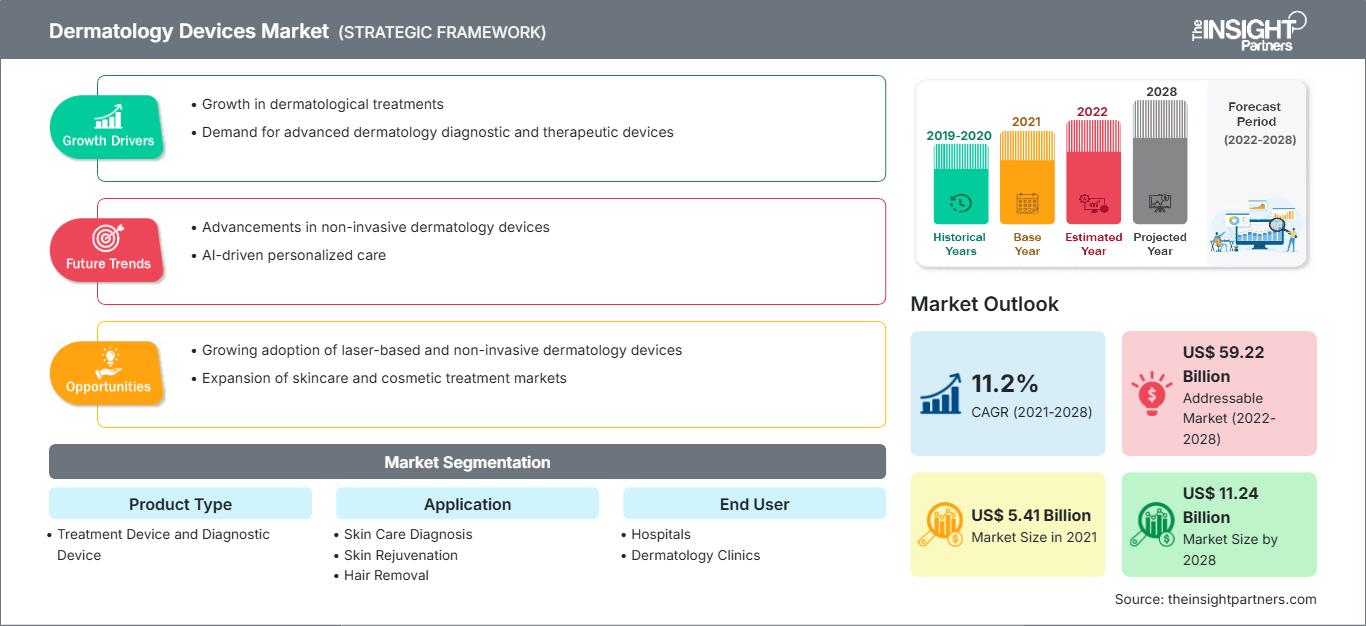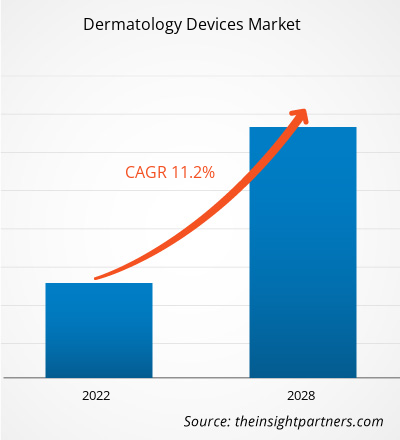Der globale Markt für Dermatologiegeräte wurde im Jahr 2021 auf 5.408,57 Millionen US-Dollar geschätzt; von 2022 bis 2028 wird ein durchschnittliches jährliches Wachstum von 11,2 % erwartet.
Der Bericht beleuchtet die aktuellen Trends im Markt für Dermatologiegeräte und die Wachstumsfaktoren. In der Dermatologie wird eine breite Palette medizinischer Geräte für kosmetische und medizinische dermatologische Eingriffe eingesetzt. Dermatologiegeräte unterstützen die Diagnose und Behandlung verschiedener Hauterkrankungen wie Hautkrebs und Schuppenflechte. Sie können auch für die Kryochirurgie, die photodynamische Therapie, die Mohs-Chirurgie sowie die Elektrodesikkation und Kürettage eingesetzt werden. Die Food and Drug Administration (FDA) spielt eine entscheidende Rolle bei der Regulierung, Zulassung und Überwachung dieser Geräte nach der Markteinführung und gewährleistet ihre Sicherheit und Wirksamkeit.
Der Bericht bietet Einblicke und eine eingehende Analyse des globalen Marktes für Dermatologiegeräte und hebt verschiedene Parameter hervor, darunter Markttrends, technologische Fortschritte, Marktdynamik und eine Analyse der Wettbewerbslandschaft führender Marktteilnehmer. Er enthält auch die Auswirkungen der COVID-19-Pandemie auf den Markt in allen Regionen. COVID-19 hatte insgesamt gemischte Auswirkungen auf den globalen Markt für Dermatologiegeräte. Die Gesundheitssysteme waren inmitten dieser globalen Gesundheitskrise überlastet und die medizinische Versorgung aller Patienten wurde in vielen Regionen zu einer zentralen Herausforderung. Darüber hinaus hatten Medizintechnikunternehmen mit dem Fortschreiten der COVID-19-Pandemie Schwierigkeiten, ihren Betrieb zu führen. Viele Hersteller von Dermatologiegeräten mit Geschäftstätigkeiten in den USA waren durch den weit verbreiteten Krankheitsausbruch negativ betroffen. Nachdem die Pandemiebeschränkungen jedoch aufgrund der sinkenden Fallzahlen gelockert wurden, normalisierte sich die Zahl der von Dermatologen durchgeführten ästhetischen Eingriffe wieder, da die Krankenhäuser wieder mit Wahleingriffen begannen, was die Nachfrage nach dermatologischen Geräten ankurbelte.
Passen Sie diesen Bericht Ihren Anforderungen an
Sie erhalten kostenlos Anpassungen an jedem Bericht, einschließlich Teilen dieses Berichts oder einer Analyse auf Länderebene, eines Excel-Datenpakets sowie tolle Angebote und Rabatte für Start-ups und Universitäten.
Markt für Dermatologiegeräte: Strategische Einblicke

- Holen Sie sich die wichtigsten Markttrends aus diesem Bericht.Dieses KOSTENLOSE Beispiel umfasst Datenanalysen, die von Markttrends bis hin zu Schätzungen und Prognosen reichen.
Sie erhalten kostenlos Anpassungen an jedem Bericht, einschließlich Teilen dieses Berichts oder einer Analyse auf Länderebene, eines Excel-Datenpakets sowie tolle Angebote und Rabatte für Start-ups und Universitäten.
Markt für Dermatologiegeräte: Strategische Einblicke

- Holen Sie sich die wichtigsten Markttrends aus diesem Bericht.Dieses KOSTENLOSE Beispiel umfasst Datenanalysen, die von Markttrends bis hin zu Schätzungen und Prognosen reichen.
Markt für Dermatologiegeräte – Geografische Einblicke
Geografisch ist der globale Markt für Dermatologiegeräte in Nordamerika (USA, Kanada und Mexiko), Europa (Deutschland, Großbritannien, Frankreich, Italien, Spanien und der Rest von Europa), Asien-Pazifik (China, Japan, Indien, Südkorea, Australien und der Rest von Asien-Pazifik), Süd- und Mittelamerika (Brasilien, Argentinien und der Rest von Süd- und Mittelamerika) sowie Naher Osten und Afrika (Saudi-Arabien, Südafrika, die Vereinigten Arabischen Emirate und der Rest von Naher Osten und Afrika) unterteilt.
Markteinblicke
Zunehmende Prävalenz von Hautkrebs und Hauterkrankungen
Laut dem Bericht der American Academy of Dermatology Association (AAD) ist Hautkrebs die am weitesten verbreitete Krebsart in den USA. Zur Erinnerung: Schätzungsweise wird in den USA täglich bei mehr als 9.500 Menschen Hautkrebs diagnostiziert. Bei den meisten Hautkrebserkrankungen handelt es sich um nichtmelanozytären Hautkrebs (NMSC). Jährlich erkranken mehr als 3 Millionen Amerikaner daran. Frauen sind am stärksten von NMSC betroffen, wobei die Raten unter der jüngeren Bevölkerung steigen. Die jährlichen Behandlungskosten für Hautkrebs in den USA werden auf 1,8 Milliarden US-Dollar geschätzt, davon 4,8 Milliarden US-Dollar für NMSC und 3,3 Milliarden US-Dollar für Melanome. Der Bericht von Frontiers SA besagt zudem, dass die Verbreitung von Hautkrebs ein globaler Trend ist. Zur Bestätigung von Hautkrebs sind Hautbiopsie und histopathologische Untersuchung unabdingbar. So hat beispielsweise die Entwicklung von Bildgebungstechnologien, -methoden und -geräten zur Aufzeichnung und Analyse rasche Fortschritte gemacht. Dermatoskopische Bildgebungsgeräte strahlen Licht auf die obere Hautschicht, um Pigmentveränderungen detailliert zu beobachten und aufzuzeichnen. Darüber hinaus hat die Entwicklung hochauflösender nichtinvasiver Diagnosegeräte wie Konfokalmikroskopie und Multiphotonenmikroskopie, die Hautläsionen auf Zellebene ohne Biopsie erkennen können, breite Marktakzeptanz gefunden. Solche innovativen Entwicklungen helfen effektiv bei der Diagnose von Hautkrebs, der genauen Beurteilung von Veränderungen bei verdächtigen Läsionen und der Effektivität nachfolgender Hautkrebsoperationen.
Hauterkrankungen sind weltweit ein großes Problem bei Teenagern und Erwachsenen. Akne, Psoriasis und Rosazea gehören zu den am weitesten verbreiteten Hauterkrankungen in der Bevölkerung. Zur Erinnerung: Akne ist die am weitesten verbreitete Hauterkrankung und betrifft laut Schätzungen der AAD jährlich bis zu 50 Millionen Amerikaner. Darüber hinaus leiden in den USA etwa 7,5 Millionen Menschen an Psoriasis, die hauptsächlich bei Erwachsenen auftritt, mit dem höchsten Anteil zwischen 45 und 64 Jahren. Darüber hinaus ist Rosazea eine häufige Hauterkrankung, von der laut einem veröffentlichten Bericht der AAD jährlich 16 Millionen Amerikaner betroffen sind. Die Diagnose solcher Hauterkrankungen kann effektiv mithilfe künstlicher Intelligenz (KI) erfolgen. Solche Faktoren würden zwischen 2022 und 2028 lukrative Möglichkeiten für den gesamten globalen Markt für Dermatologiegeräte bieten.
Markt für Dermatologiegeräte – Produktbasierte Einblicke
Basierend auf dem Produkttyp ist der globale Markt für Dermatologiegeräte in Behandlungsgeräte und Diagnosegeräte unterteilt. Das Segment Behandlungsgeräte hatte 2021 einen größeren Marktanteil.
Markt für Dermatologiegeräte – Anwendungsbasierte Einblicke
Basierend auf der Anwendung ist der globale Markt für Dermatologiegeräte in Hautkrebsdiagnose, Hautverjüngung, Haarentfernung, Körperkonturierung & Hautstraffung, Psoriasis und andere unterteilt. Das Segment Hautkrebsdiagnose hatte 2021 den größten Marktanteil.
DermatologiegeräteRegionale Einblicke in den Markt für Dermatologiegeräte
Die Analysten von The Insight Partners haben die regionalen Trends und Faktoren, die den Markt für Dermatologiegeräte im Prognosezeitraum beeinflussen, ausführlich erläutert. In diesem Abschnitt werden auch die Marktsegmente und die geografische Lage in Nordamerika, Europa, dem asiatisch-pazifischen Raum, dem Nahen Osten und Afrika sowie Süd- und Mittelamerika erörtert.
Umfang des Marktberichts über Dermatologiegeräte
| Berichtsattribut | Einzelheiten |
|---|---|
| Marktgröße in 2021 | US$ 5.41 Billion |
| Marktgröße nach 2028 | US$ 11.24 Billion |
| Globale CAGR (2021 - 2028) | 11.2% |
| Historische Daten | 2019-2020 |
| Prognosezeitraum | 2022-2028 |
| Abgedeckte Segmente |
By Produkttyp
|
| Abgedeckte Regionen und Länder | Nordamerika
|
| Marktführer und wichtige Unternehmensprofile |
|
Dichte der Marktteilnehmer für Dermatologiegeräte: Verständnis ihrer Auswirkungen auf die Geschäftsdynamik
Der Markt für Dermatologiegeräte wächst rasant. Die steigende Nachfrage der Endverbraucher ist auf Faktoren wie veränderte Verbraucherpräferenzen, technologische Fortschritte und ein stärkeres Bewusstsein für die Produktvorteile zurückzuführen. Mit der steigenden Nachfrage erweitern Unternehmen ihr Angebot, entwickeln Innovationen, um den Bedürfnissen der Verbraucher gerecht zu werden, und nutzen neue Trends, was das Marktwachstum weiter ankurbelt.

- Holen Sie sich die Markt für Dermatologiegeräte Übersicht der wichtigsten Akteure
Markt für Dermatologiegeräte – Endnutzerbasierte Einblicke
Basierend auf den Endnutzern ist der globale Markt für Dermatologiegeräte in Krankenhäuser, dermatologische Kliniken und andere segmentiert. Das Krankenhaussegment hielt 2021 den größten Marktanteil. Allerdings wird das Segment der dermatologischen Kliniken zwischen 2022 und 2028 voraussichtlich mit der höchsten CAGR wachsen.
Alma Lasers (Sisram Medical), Cutera Inc., Candela Corporation, Solta Medical (Bausch Health Companies Inc.), FotoFinder Systems's, Cynosure, Lumenis, El.En SpA, Leica Microsystem und Aerolase Corp. gehören zu den wichtigsten Akteuren auf dem globalen Markt für Dermatologiegeräte. Die Marktteilnehmer verfolgen organische Strategien, darunter Produkteinführungen und -erweiterungen, um ihre Präsenz und ihr Produktportfolio weltweit zu erweitern.
- Historische Analyse (2 Jahre), Basisjahr, Prognose (7 Jahre) mit CAGR
- PEST- und SWOT-Analyse
- Marktgröße Wert/Volumen – Global, Regional, Land
- Branchen- und Wettbewerbslandschaft
- Excel-Datensatz
Aktuelle Berichte
Erfahrungsberichte
Grund zum Kauf
- Fundierte Entscheidungsfindung
- Marktdynamik verstehen
- Wettbewerbsanalyse
- Kundeneinblicke
- Marktprognosen
- Risikominimierung
- Strategische Planung
- Investitionsbegründung
- Identifizierung neuer Märkte
- Verbesserung von Marketingstrategien
- Steigerung der Betriebseffizienz
- Anpassung an regulatorische Trends






















 Kostenlose Probe anfordern für - Markt für Dermatologiegeräte
Kostenlose Probe anfordern für - Markt für Dermatologiegeräte